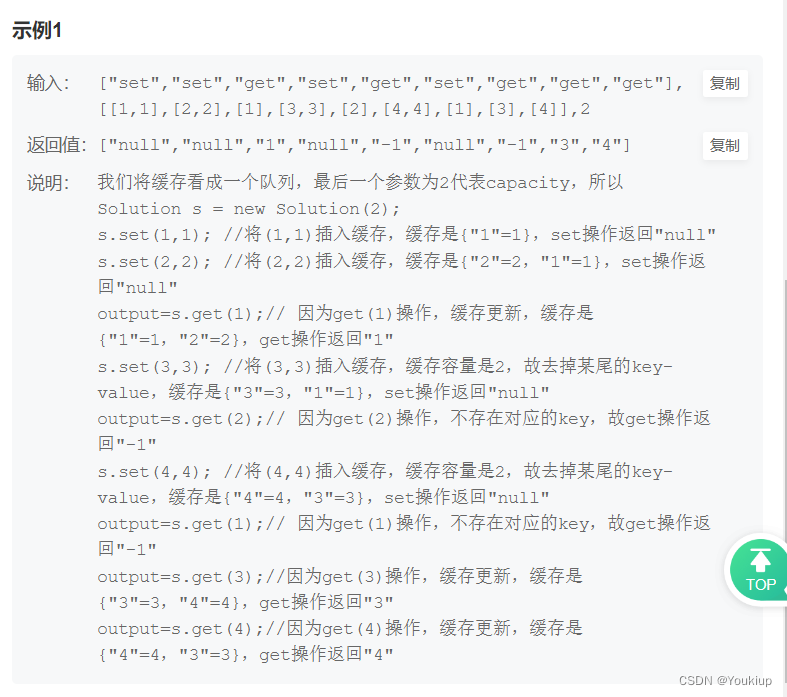题目
描述
设计LRU(最近最少使用)缓存结构,该结构在构造时确定大小,假设大小为 capacity ,操作次数是 n ,并有如下功能:
- Solution(int capacity) 以正整数作为容量 capacity 初始化 LRU 缓存
- get(key):如果关键字 key 存在于缓存中,则返回key对应的value值,否则返回 -1 。
- set(key, value):将记录(key, value)插入该结构,如果关键字 key 已经存在,则变更其数据值 value,如果不存在,则向缓存中插入该组 key-value ,如果key-value的数量超过capacity,弹出最久未使用的key-value
提示:
1.某个key的set或get操作一旦发生,则认为这个key的记录成了最常使用的,然后都会刷新缓存。
2.当缓存的大小超过capacity时,移除最不经常使用的记录。
3.返回的value都以字符串形式表达,如果是set,则会输出"null"来表示(不需要用户返回,系统会自动输出),方便观察
4.函数set和get必须以O(1)的方式运行
5.为了方便区分缓存里key与value,下面说明的缓存里key用""号包裹


分析
python 的话,直接用collection 中的 OrderedDict
OrderedDict 是 Python 标准库 collections 模块中的一个特殊字典类,其核心特性是维护了元素添加的顺序。这与 Python 3.7 及以上版本中的普通字典不同,尽管普通字典现在也保持插入顺序,但 OrderedDict 提供了一些额外的功能,这些功能在普通字典中不可用。
顺序性:
OrderedDict 记录了元素被添加到字典中的顺序。这对于需要元素顺序的场景(如实现LRU缓存)非常有用。
重排功能:
使用 move_to_end 方法可以将一个键值对移动到有序字典的末尾或开头,这在调整元素顺序时非常方便。
常用方法
popitem(last=True): 弹出并返回一个键值对。如果 last 为 True(默认值),则按 LIFO(后进先出)顺序返回最后一个添加的元素;如果为 False,则按 FIFO(先进先出)顺序返回第一个添加的元素。
move_to_end(key, last=True): 将存在的键 key 移动到字典的末尾(如果 last=True)或字典的开头(如果 last=False)。
示例代码
下面是一个简单的示例,展示了 OrderedDict 的一些基本用法:
python
from collections import OrderedDict
# 创建有序字典
od = OrderedDict()
od['a'] = 1
od['b'] = 2
od['c'] = 3
# 访问顺序
for key, value in od.items():
print(key, value) # a 1, b 2, c 3
# 移动元素 'b' 到末尾
od.move_to_end('b')
for key, value in od.items():
print(key, value) # a 1, c 3, b 2
# 弹出最先加入的元素
od.popitem(last=False)
for key, value in od.items():
print(key, value) # c 3, b 2代码
python
from collections import OrderedDict
class Solution:
def __init__(self, capacity: int):
# write code here
self.capacity = capacity
self.lru_cache = OrderedDict()
def get(self, key: int) -> int:
# write code here
if key in self.lru_cache:
self.lru_cache.move_to_end(key)
return self.lru_cache.get(key,-1)
def set(self, key: int, value: int) -> None:
# write code here
if key in self.lru_cache:
# self.lur_cache.move_to_end(key)
del self.lru_cache[key]
self.lru_cache[key] = value
if len(self.lru_cache)>self.capacity:
self.lru_cache.popitem(last=False)
# Your Solution object will be instantiated and called as such:
# solution = Solution(capacity)
# output = solution.get(key)
# solution.set(key,value)